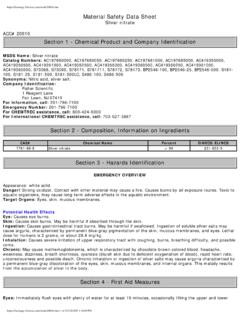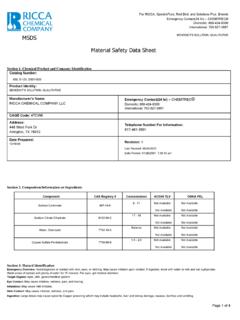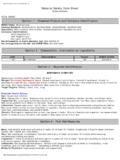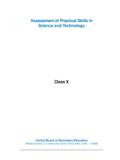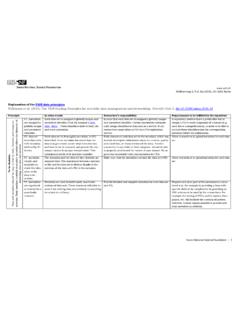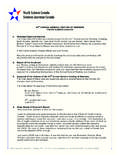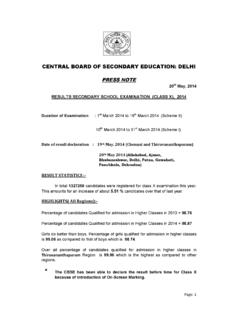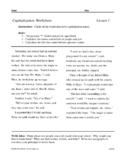Transcription of Material Safety Data Sheet Hyflo *Super-Cel* Filter …
1 Safety data Sheet Hyflo * super -Cel* Filter Aid ACC# 41143 Section 1 - Chemical Product and Company IdentificationMSDS Name: Hyflo * super -Cel* Filter Aid Catalog Numbers: H333-3, NC9840678 Synonyms: Infusorial earth Company Identification: Fisher Scientific 1 Reagent Lane Fair Lawn, NJ 07410 For information, call: 201-796-7100 Emergency Number: 201-796-7100 For CHEMTREC assistance, call: 800-424-9300 For International CHEMTREC assistance, call: 703-527-3887 Section 2 - Composition, Information on Ingredients CAS#Chemical NamePercentEINECS/ELINCS68855-54-9 Kieselguhr, soda ash flux-calcined100 272-489-014464-46-1 Silica, cristobalite<40 238-455-414808-60-7 Quartz<4 238-878-4 Section 3 - Hazards Identification EMERGENCY OVERVIEWA ppearance: light gray solid. Caution! May cause eye, skin, and respiratory tract irritation.
2 Contains trace amounts of quartz which may lead to fibrotic lung disease, silicosis or cancer. Target Organs: Lungs. Potential Health Effects Eye: May cause eye irritation. Skin: Dust may cause mechanical irritation. Ingestion: May cause irritation of the digestive tract. Inhalation: May cause respiratory tract irritation. Chronic: Prolonged exposure to respirable crystalline quartz may cause delayed lung injury/fibrosis (silicosis). Section 4 - First Aid Measures Eyes: Flush eyes with plenty of water for at least 15 minutes, occasionally lifting the upper and lower eyelids. Get medical aid. Skin: Get medical aid if irritation develops or persists. Wash clothing before reuse. Flush skin with plenty of soap and water. Ingestion: If victim is conscious and alert, give 2-4 cupfuls of milk or water. Never give anything by mouth to an unconscious person.
3 Get medical aid. Get medical aid if irritation or symptoms occur. Inhalation: Remove from exposure and move to fresh air immediately. If not breathing, give artificial respiration. If breathing is difficult, give oxygen. Get medical aid. Notes to Physician: No specific antidote exists. Treat symptomatically and supportively. (1 of 5)7/23/2007 12:58:13 5 - Fire Fighting Measures General Information: As in any fire, wear a self-contained breathing apparatus in pressure-demand, MSHA/NIOSH (approved or equivalent), and full protective gear. During a fire, irritating and highly toxic gases may be generated by thermal decomposition or combustion. Extinguishing Media: Use extinguishing media most appropriate for the surrounding fire. Flash Point: Not applicable. Autoignition Temperature: Not applicable. Explosion Limits, Lower:Not available. Upper: Not available.
4 NFPA Rating: (estimated) Health: 1; Flammability: 0; Instability: 0 Section 6 - Accidental Release Measures General Information: Use proper personal protective equipment as indicated in Section 8. Spills/Leaks: Clean up spills immediately, observing precautions in the Protective Equipment section. Sweep up, then place into a suitable container for disposal. Avoid generating dusty conditions. Provide ventilation. Section 7 - Handling and Storage Handling: Wash thoroughly after handling. Use with adequate ventilation. Minimize dust generation and accumulation. Avoid contact with skin and eyes. Avoid ingestion and inhalation. Storage: Store in a cool, dry, well-ventilated area away from incompatible substances. Section 8 - Exposure Controls, Personal Protection Engineering Controls: Use adequate general or local exhaust ventilation to keep airborne concentrations below the permissible exposure limits.
5 Exposure Limits Chemical NameACGIHNIOSHOSHA - Final PELsKieselguhr, soda ash flux-calcined none listed none listed none listed Silica, cristobalite mg/m3 TWA (respirable fraction) 25 mg/m3 IDLH (respirable dust) none listed Quartz mg/m3 TWA (respirable fraction) mg/m3 TWA (respirable dust) 50 mg/m3 IDLH (respirable dust) none listed OSHA Vacated PELs: Kieselguhr, soda ash flux-calcined: No OSHA Vacated PELs are listed for this chemical. Silica, cristobalite: mg/m3 TWA (respirable dust) Quartz: mg/m3 TWA (respirable dust) Personal Protective Equipment Eyes: Wear appropriate protective eyeglasses or chemical Safety goggles as described by OSHA's eye and face protection regulations in 29 CFR or European Standard EN166. Skin: Wear appropriate gloves to prevent skin exposure. Clothing: Wear appropriate protective clothing to minimize contact with skin.
6 Respirators: Follow the OSHA respirator regulations found in 29 CFR or European Standard EN 149. Use a NIOSH/MSHA or European Standard EN 149 approved respirator if exposure limits are exceeded or if irritation or other symptoms are experienced. (2 of 5)7/23/2007 12:58:13 9 - Physical and Chemical Properties Physical State: Solid Appearance: light gray Odor: odorless pH: 5-10 Vapor Pressure: 10 mm Hg @ 1732 deg C Vapor Density: Not available. Evaporation Rate:Not available. Viscosity: Not available. Boiling Point: 2230 deg C Freezing/Melting Point:1710 deg C Decomposition Temperature:Not available. Solubility: Insoluble in water Specific Gravity/ Molecular Formula:SiO2 Molecular Section 10 - Stability and Reactivity Chemical Stability: Stable under normal temperatures and pressures. Conditions to Avoid: Dust generation. Incompatibilities with Other Materials: Hydrogen fluoride, strong acids.
7 Hazardous Decomposition Products: None. Hazardous Polymerization: Will not occur. Section 11 - Toxicological Information RTECS#: CAS# 68855-54-9 unlisted. CAS# 14464-46-1: VV7325000 CAS# 14808-60-7: VV7330000 LD50/LC50: Not available. Not available. Not available. Carcinogenicity: CAS# 68855-54-9: Not listed by ACGIH, IARC, NTP, or CA Prop 65. CAS# 14464-46-1: l ACGIH: Not listed. l California: Not listed. l NTP: Known carcinogen (listed as Silica, crystalline (general form)). l IARC: Group 1 carcinogenCAS# 14808-60-7: l ACGIH: A2 - Suspected Human Carcinogen l California: carcinogen, initial date 10/1/88 (airborne particles of respirable size) l NTP: Known carcinogen l IARC: Group 1 carcinogen (3 of 5)7/23/2007 12:58:13 : No information available. Teratogenicity: No information available.
8 Reproductive Effects: No information available. Mutagenicity: No information available. Neurotoxicity: No information available. Other Studies: Section 12 - Ecological Information Ecotoxicity: No data available. No information available. Environmental: Aquatic: Will settle in sediment. Terrestrial: Low mobility in soil. Atmospheric: Will eventually settle out. Physical: No information available. Other: No information available. Section 13 - Disposal Considerations Chemical waste generators must determine whether a discarded chemical is classified as a hazardous waste. US EPA guidelines for the classification determination are listed in 40 CFR Parts Additionally, waste generators must consult state and local hazardous waste regulations to ensure complete and accurate classification. RCRA P-Series: None listed. RCRA U-Series: None listed.
9 Section 14 - Transport Information US DOTC anada TDGS hipping Name:Not regulated as a hazardous materialNo information Class:UN Number:Packing Group: Section 15 - Regulatory Information US FEDERAL TSCA CAS# 68855-54-9 is listed on the TSCA inventory. CAS# 14464-46-1 is listed on the TSCA inventory. CAS# 14808-60-7 is listed on the TSCA inventory. Health & Safety Reporting List None of the chemicals are on the Health & Safety Reporting List. Chemical Test Rules None of the chemicals in this product are under a Chemical Test Rule. Section 12b None of the chemicals are listed under TSCA Section 12b. TSCA Significant New Use Rule None of the chemicals in this Material have a SNUR under TSCA. CERCLA Hazardous Substances and corresponding RQs None of the chemicals in this Material have an RQ. SARA Section 302 Extremely Hazardous Substances None of the chemicals in this product have a TPQ.
10 SARA Codes CAS # 14808-60-7: delayed. Section 313 No chemicals are reportable under Section 313. (4 of 5)7/23/2007 12:58:13 Air Act: This Material does not contain any hazardous air pollutants. This Material does not contain any Class 1 Ozone depletors. This Material does not contain any Class 2 Ozone depletors. Clean Water Act: None of the chemicals in this product are listed as Hazardous Substances under the CWA. None of the chemicals in this product are listed as Priority Pollutants under the CWA. None of the chemicals in this product are listed as Toxic Pollutants under the CWA. OSHA: None of the chemicals in this product are considered highly hazardous by OSHA. STATE CAS# 68855-54-9 can be found on the following state right to know lists: Pennsylvania. CAS# 14464-46-1 can be found on the following state right to know lists: New Jersey, Pennsylvania, Minnesota, Massachusetts.

